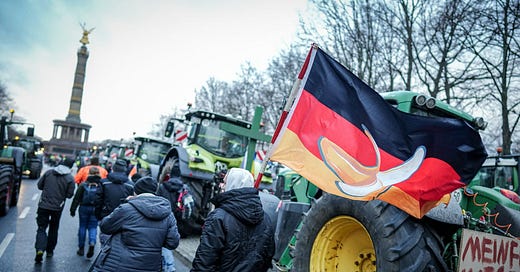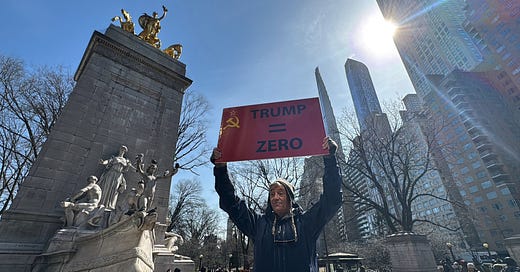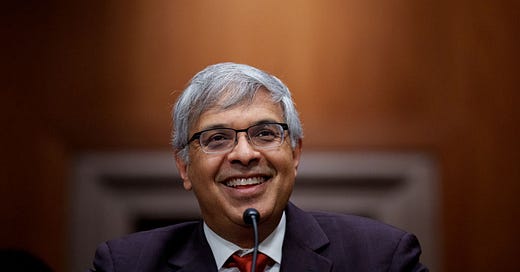
The Free Press

From Europe to America, mass protest movements increasingly take place on wheels. The streets of Berlin have been choked in the past couple of weeks by the tractors of farmers protesting government cuts in diesel fuel subsidies for vehicles and farm machinery, with similar protests taking place in France, Poland, and Romania.
Beginning in 2018, the streets of central Paris were barricaded by the yellow vest movement, which similarly began as a protest against increases in fuel prices justified by environmental concerns, the costs of which fell chiefly on the inhabitants and businesses of the nonmetropolitan periphery. In the Netherlands in March 2023, the Farmer-Citizen Movement (begun in 2019 by critics of government plans to reduce nitrogen emissions by eliminating thousands of farms and reducing livestock numbers) gained enough support from opponents of the Dutch establishment to become the biggest party in the upper house of the Dutch parliament.
In 2022, what began as a movement opposing a Canadian government vaccine mandate on truckers who crossed the U.S.-Canadian border expanded into the “Freedom Convoy” that shut down Ottawa and forced the Canadian prime minister Justin Trudeau to invoke a state of emergency to disperse the protesters in their vehicles.
Many critics of these protests in Western establishments have dismissed them as far-right conspiracies against liberal democracy because right-wing extremists have often sought to exploit them for political purposes. Other critics dismiss the truckers and farmers as pampered special interests, whining about the withdrawal of unjustified subsidies or objecting to perfectly reasonable regulations. When they are not neo-Nazis, much of the establishment would have us believe, the mutinous farmers and truckers are merely corrupt “crony capitalists.”
But there have been far-right extremists and fuel and agriculture subsidies for generations. Only factors unique to the present conjuncture can explain these similar and near-simultaneous uprisings. One factor is the commitment of Euro-American elites to impose a costly transition away from fossil fuels, regardless of the price. The other is the difficulty of achieving successful workplace strikes in an era of offshored manufacturing and decentralized, small-scale service firms compared with truck and car blockades that can shut down whole national economies. The truck or tractor convoy may replace the picket line as the symbol of class conflict in the deindustrialized nations of the West.
Manufacturing industries along with the working class have been driven out, by prices and regulations, from the cities, such as New York and London, that the college-credentialed overclass seek to reconstruct as clean, walkable, resort-like settings for high-end consumption by professionals in business and finance. Whatever the merits of America’s Green New Deal, the EU’s Green Deal, and the British equivalent may be, the costs of a rapid transition to “net zero” carbon emissions fall much more heavily on the employment and consumption of non-college-educated workers of all races as well as on the manufacturing and agricultural industries in which they are overrepresented.
At the same time, these beleaguered constituencies have lost their traditional voice in social democratic parties and have yet to be adequately represented by parties of the right in Europe and North America. It was not that long ago that industrial workers and farm workers and small farmers were championed by the radical as well as the moderate left. According to legend, Leon Trotsky, in exile in New York City before the Russian Revolution, began a speech with the words: “Workers and peasants of the Bronx!” Even if that incident is apocryphal, communists around the world claimed to represent the interests of both kinds of toilers.
Centrist social democracy, too, rested on farmer-labor alliances. The New Deal coalition that dominated U.S. politics for half a century after the Great Depression was based on factory workers in the industrial northeast and farmers in the Southern and Western periphery. In Sweden, the Social Democrats laid the foundation for their long dominance with the “cow deal” of 1933 between representatives of urban workers and Swedish agrarians.
But as the shares of the electorate and workforce accounted for by farmers and industrial works have declined, parties of the center left have dissolved their own constituency and elected a new one, consisting of two kinds of service sector workers: highly educated, highly paid professionals and managers concentrated in a small number of metropolitan areas, and a supporting cast of disproportionately foreign-born service workers and personal servants such as maids, nannies, and gardeners. Meanwhile, working class and rural citizens are becoming aligned, geographically and culturally. The combination of high property costs and low wages in European and American cities have forced most members of the working class into suburbs and exurbs or small towns, with big cities rescued from depopulation only by a constant influx of immigrants to replace the citizens and naturalized immigrants who move out.
Like agriculture, manufacturing also tends to be located in low-density areas, a trend that dates back a century to the dispersal of factories to greenfield areas that trucking and rural electrification made possible. Compared to U.S. cities, nonmetropolitan areas have higher shares of employment in both manufacturing and agriculture. Agriculture itself, according to the U.S. government, employs fewer people in rural America than the largest occupational categories, in order: government, manufacturing, retail, and healthcare and social assistance, with some farm families depending on part-time work or full-time work by one member in these occupations.
The rural workforce is less likely to have a college education than metropolitan residents. In Europe as well as North America, the old dichotomy of rural farmers and urban proletarians has given way to a new “rurban” or “exurban” economy in which less educated people work in a variety of occupations.
While nonmetropolitan areas are becoming more diverse in occupational structure and ethnicity, cultural divisions are hardening between their residents and the upscale inhabitants of downtowns and inner suburbs. Some on the center left have hoped to win rural support with subsidized green manufacturing in “left behind” areas. But so far the rural renaissance envisioned by proponents of building solar and wind facilities and battery factories in rural areas has not materialized in the U.S., where, according to the federal government in 2023, clean energy jobs as a share of employment ranged in nonmetropolitan regions in different states from 0.5 percent to a paltry 2.6 percent.
Furthermore, attempts to use the reshoring of industry, green and otherwise, to rebuild something like the old farmer-labor coalition to the left of center in Europe and America may be doomed by the abrupt tendency of the metropolitan elite to take up new causes such as transgender rights and Black Lives Matter–style “equity,” and immediately seek to impose their newly adopted values on the rest of the population by government policy and private economic coercion. Most of the members of the multiracial working class have moved out of dense urban neighborhoods, only to find themselves subject in their new homes to ceaseless moralistic hectoring and coercive social engineering efforts by the affluent urbanites who dominate national government.
As green mandates and vaccine mandates have triggered protests from populations already aggrieved by top-down metropolitan moral crusades, workers and the self-employed in some industries have been able to respond more forcefully than those in other sectors. The recent victories of the United Auto Workers (UAW) union in the U.S. prove that workers in manufacturing can still win occasional victories, even in a country as hostile to organized labor as the contemporary U.S. Even so, globalization has reduced the bargaining power of assembly-line employees, by allowing companies seeking to minimize labor costs to transfer supply chains to low-wage, nonunionized workforces in foreign countries. But this tactic cannot be used in domestic infrastructure industries and agriculture. Infrastructure, including transportation systems based on rail, trucking, and air and public utilities, cannot be offshored. In theory countries can import all their food from abroad, but in practice a combination of national security considerations and popular support for family farmers leads all industrial nations to maintain and subsidize national food systems.
What is more, the Covid-19 pandemic revealed a striking divide between “essential workers” in industries such as food processing, manufacturing, transportation, and healthcare, all of which are overrepresented outside of dense downtowns, and service workers in amenity sectors, particularly luxury sectors catering to the urban professional class, like upscale restaurants and hair salons. In December 2020, for example, pandemic-induced unemployment in the U.S. among workers in leisure and hospitality was 16.7 percent but was only 4.3 percent in manufacturing—lower even than 6.1 percent in business and professional services.
The greater dependence of society on disproportionately rural and exurban essential service workers gives them leverage that hairstylists and house cleaners lack. Their ability to control choke points in food production and the distribution of goods of all kinds gives workers and small producers in agriculture and logistical industries leverage that has been lost to workers in factories, because of how the latter can be replaced by foreign factories if they seek to unionize or improve their union contracts. Instead of shutting down only a single establishment, these producers can threaten to shut down the entire economy. And unlike traditional picket lines, flash mobs of trucks or cars or tractors are flexible and can coalesce quickly at chosen targets.
The eclipse of manufacturing by infrastructure and family farming as flashpoints of social conflict marks a return to the earliest phase of the Industrial Revolution more than a century ago. Before factory employment became significant, “agrarianism” in the sense of the breakup of large estates and their distribution to family farmers was often a synonym for “socialism.” Decades before the rise of large manufacturing firms at the end of the nineteenth century, the railways in the U.S. were the dominant big businesses. Some of the bloodiest labor violence in America involved rail strikes, as did early victories for organized labor, including the Railway Labor Act of 1926, which legalized collective bargaining and created a national system of government arbitration in the rail and transit industry nearly a decade before the same was done for other industries by the National Labor Relations Act or “Wagner Act” of 1935. Eugene Debs, the socialist candidate for president of the U.S. whom the government jailed during the First World War, began as a labor organizer in the rail industry, as did A. Philip Randolph, the founder of the Brotherhood of Sleeping Car Porters and the greatest African American civil rights leader of the twentieth century, along with Martin Luther King Jr.
In the years ahead, it seems likely that this new pattern of revolts by the exurban working class and small producers and the self-employed against economic and social mandates imposed by metropolitan centers will be the major form that class struggle takes in Europe, North America, and other developed regions. Many rural and exurban residents may rally around protesters in occupations other than their own, based on a shared resentment of the aggressive overreach of elite urbanites. While the picket lines of the past were accompanied by chanted slogans, the class struggles of the future may be punctuated by choruses of honking horns.
A version of this article was first published in the New Statesman. Michael Lind is a columnist at Tablet and a fellow at New America. His most recent book is The New Class War: Saving Democracy from the Managerial Elite.
Become a Free Press subscriber today:
















With a General Election looming in the UK, any Party that stood on a ticket to stop the nut-zero nonsense would win a landslide. We have a huge surcharge on our electricity and gas bills that funds subsidies to build wind and solar (at our latitude!) farms, we pay huge tax rates on vehicle fuel and we’re being penalised for not changing our perfectly efficient gas fired boilers to heat pumps, which don’t really work in a lot of our housing stock because of insulation levels. Car manufacturers will soon be being fined for not selling more EVs, yet the manufacturers are responding to the lack of interest in EVs by cutting back their investment in them: VW, Peugeot, Volvo have all been pulling back.
For some time I have considered our Truckers' protest (I am Canadian) to be class conflict - but no-one in the media here - even the conservative right have noticed this. So, thanks for your article!